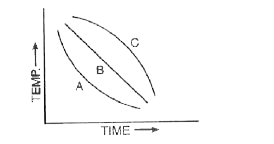Multiple Choice Questions (Level - III) Questions From AIEEE/JEE Examination) from MODERN PUBLICATION PHYSICS (KANNADA ENGLISH) TRANSFERENCE OF HEAT for Class 12
| Class 12 | PHYSICS |
| Chapter | TRANSFERENCE OF HEAT |
| MODERN PUBLICATION PHYSICS (KANNADA ENGLISH) | Multiple Choice Questions (Level - III) Questions From AIEEE/JEE Examination) |
| Medium | English |
| Academic Year | 2023-2024 |
Question 69
Two slabs A and B, each though similar, in all other respects, have different materials. They are placed one above the other in perfect contact and a steady difference of temperature of 36∘C is maintained across the combination. If the thermal conductivity of A is twice that of B, what is the temperature of interface ? View SolutionQuestion 77
A wall has two layers A and B, each made of defferent material. A has thickness 10 cm, while B has thickness 20 cm, their coefficients of conductivities are in the ratio of 3:1. A constant temperature difference of 35∘C exists across the wall. The difference of temperature across the layer A is : View SolutionQuestion 81
A cylindrical rod with one end in steam and other end in ice results in melting of 0.1 g of ice per second. If the rod is replaced by another with half the length and double the radius and 1/4th the conductivity than that of the first, the rate at which the ice melts in g/sec will be : View SolutionQuestion 83
Two spheres of different materials, one with double the radius but 1/4 th wall thickness than other are filled with ice. If the time taken for complete melting of ice in the bigger sohere is 25 minutes and that in smaller is 16 minutes, the ratio of the thermal conductivities of larger to the smaller is : View SolutionQuestion 95
Raed the following passage and and answer the following questions.
Stefan's law states that the ernergy emitted per second per unit area of the perfect black body is directly proportional to fourth power of its absolute temperature i.e. E∝T4 or E=σT4 where σ is called Stefan's constant. If the body is placed in enclosure maintained at temperature T0 then E=σ(T4−T40). If temperature difference between the body and the surroundings is very small then energy emitted per second per unit area of the body and surrounding i.e E∝(T−T0). This is known as Newton's Law of cooling and is a special case of Stefan's Law.
Two bodies P and Q are having equal surface areas and are maintained at temperature 17∘C and 27∘C respectively. Then radiant energy emitted per second are in the ratio of : View SolutionQuestion 102
Two identical conducting rods are first connected independently to two vessels, one containing water at 100∘C, and the other containing ice at 0∘C. In the second case, the rods are joined end to end and connected to the same vessels. Let q1,q2 gram/sec be the rate of melting of ice in the two cases respectively. The ratio q1/q2 is : View SolutionQuestion 109
One end of a copper rod of length 1.0m and area of cross-section 10−3m2 is immersed in boiling water and the other ens in ice. If the coefficient of thermal conductivity of copper is 92 cal/m-s- ∘C and the latent heat of ice is 8×104 cal/kg, then the amount of ice which will melt in one munite is : View SolutionQuestion 117
A composite block is made of slabs A,B,C,D and E of different thermal conductivities (given in terms of a constant K) and sizes (given in terms of length, L) as shown in the figure. All slabs are of same width. Heat 'Q' flows only from left to right through the blocks.
Then in steady state
 View Solution
View SolutionQuestion 120
Three rods of Copper, Brass and Steel are welded to - gether to from a Y-shaped structure. Area of cross-section of each rod = 4 cm2. End of copper rod is maintained at 100∘C whereas ends of brass and steel are kept at 0∘C. Lengths of the copper, brass and steel rods are 46, 13 and 12 cm respectively. The rods are thermally insulated from surroundings except at ends. Thermal conductivities of copper, brass and steel are 0.92,0.26 and 0.12 CGS units respectively. Rate of heat flow through copper rod is : View SolutionQuestion 121
Consider a spherical shell of radius R at temperature T. The black body radiation inside it can be considered as an ideal gas of photons with internal energy per unit colume u=UV∝T4 and pressure P=13(UV). If the shell now undergoes an adiabatic expansion the relation between T and R is : View Solution




